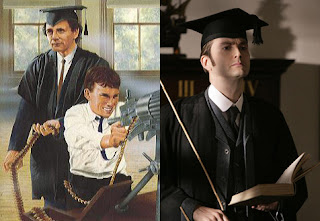
I adore the Doctor Who New Adventures novels, published by Virgin between 1991 and 1997. These books picked up where Survival left off, as Sylvester McCoy's Doctor wandered off screen arm-in-arm with Ace, and took off in new and interesting directions. Like the TV series itself the quality varied wildly from book to book, but at their best the New Adventures easily surpassed the TV series.
Paul Cornell was one of the leading lights of the New Adventures; the first of many fan writers to break into series with the ground-breaking Timewyrm: Revelation. Cornell's fourth New Adventure, Human Nature, is widely considered to be the absolute pinnacle of the New Adventures. The novel sees the Doctor transform himself into the human John Smith, who unaware of his Time Lord origins, become a teacher at a English boy's school just prior to the First World War and fall in love with Joan Redfern until a hostile family of aliens disrupts his peaceful existence. Such is the power of this book that when I first read it I was actually desperate for the Doctor to stay with Joan at the end even though I knew that this couldn't happen.
I regarded the news that Cornell was adapting his novel for television with some trepidation. I wasn't too bothered about the implications for the series continuity as I'd long regarded the New Adventures as a separate branch from the TV episodes, rather I was worried that the TV story wouldn't do the novel justice and that the changes required to make this fit the new Doctor and companion would be to its detriment.
Last night I saw the first episode of this two-part story, and I was astonished at just how amazingly good it was. I've been rather disappointed by a few of the episodes this year but Human Nature rises head and shoulders above the rest. I was concerned that the Tenth Doctor was already too light and accessible to convincingly make the transition to a truly human character (one of the strengths of the novel had been that the Seventh Doctor had become increasing dark, manipulative and alien in the New Adventures so his 'humanisation' was a stark and wholly effective contrast), but David Tennant pulls off a nuanced performance as John Smith with consumate ease. The TV version also looks exactly right - it is as if the story I'd imagined back in 1995 when I read the novel has been lifted from my mind and plonked on the TV screen. It's a very uncanny experience but hugely satisfying all the same!
If this is what the new series can do with a classic New Adventures novel as its source, then perhaps more of these books should be brought to screen? What could the new series do with an adaptation of The Also People, The Dying Days, or even Russell T Davies' own Damaged Goods...?
Meanwhile I am really, really looking forward to next week's episode!

